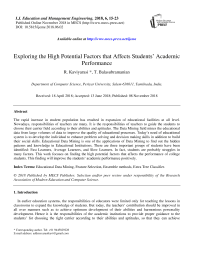Exploring the high potential factors that affects students’ academic performance
Автор: R. Kaviyarasi, T. Balasubramanian
Журнал: International Journal of Education and Management Engineering @ijeme
Статья в выпуске: 6 vol.8, 2018 года.
Бесплатный доступ
The rapid increase in student population has resulted in expansion of educational facilities at all level. Nowadays, responsibilities of teachers are many. It is the responsibilities of teachers to guide the students to choose their carrier field according to their abilities and aptitudes. The Data Mining field mines the educational data from large volumes of data to improve the quality of educational processes. Today’s need of educational system is to develop the individual to enhance problem solving and decision making skills in addition to build their social skills. Educational Data Mining is one of the applications of Data Mining to find out the hidden patterns and knowledge in Educational Institutions. There are three important groups of students have been identified: Fast Learners, Average Learners, and Slow Learners. In fact, students are probably struggles in many factors. This work focuses on finding the high potential factors that affects the performance of college students. This finding will improve the students’ academic performance positively.
Educational Data Mining, Feature Selection, Ensemble methods, Extra Tree Classifier
Короткий адрес: https://sciup.org/15015784
IDR: 15015784 | DOI: 10.5815/ijeme.2018.06.02
Список литературы Exploring the high potential factors that affects students’ academic performance
- Jayashree M Kudari. 2016. “Survey on the Factors Influences the Students’ Academic Performance”. International Journal of Emerging Research in Management &Technology. ISSN: 2278-9359 (Volume-5, Issue-6).
- Jason Brownlee. 2014. “Feature Selection in Python with Scikit-Learn”. (July 2014). Retrieved March 21, 2018 from https://machinelearningmastery.com/feature-selection-in-python-with-scikit-learn/
- Jasmina NOVAKOVIĆ, Perica STRBAC, Dusan BULATOVIĆ. 2011. “Toward Optimal Feature Selection Using Ranking Methods and Classification Algorithms”. Yugoslav Journal of Operations Research.21 (2011), Number 1, 119-135.DOI: 0.2298/YJOR1101119N
- Giovanni Seni, John F. Elder. 2010. “Ensemble Methods in Data Mining: Improving Accuracy Through Combining Predictions”. Morgan & Claypool publishers.
- Jason Brownlee. 2016. “Ensemble Machine Learning Algorithms in Python with scikit-learn”. (June 2016). Retrieved March 27. 2018 from https:// machinelearningmastery.com/ensemble-machine-learning-algorithms-python-scikit-learn/
- Sergio Ledesma, Gustavo Cerda, Gabriel Avina, Donato Hernandez, and Miguel Torre. “Feature Selection Using Artificial Neural Networks”. Mexican International Conference on Artificial Intelligence. MICAI 2008: Advances in Artificial Intelligence pp 351-359 Retrieved from https://link.springer.com/chapter/10.1007/978-3-540-88636-5_34
- Zhi-Hua Zhou. 2012. CRC Press Taylor & Francis Group. “Ensemble Methods Foundations and Algorithms”.
- Raheela Asif, Agathe Merceron, Syed Abbas Ali and Najmi Ghani Haider. “Analyzing undergraduate students’ performance using educational data mining”. Computers & Education. 113 (2017) 177-194.
- Cristobal Romero, Manuel – Ignacio Lopez, Jose- Maria Luna and Sebastian Ventura. “Predicting students’ final Perfromance from participation in on-line discussion forums”. Computers & Education 68(2013) 458-472.
- Anne – Sophie Hoffait, Michael Schyns. “Early detection of university students with potential difficulties”. Decision Support Systems 101(2017) 1-11.
- Ashwin Satyanarayana, Mariusz Nuckowski. “Data Mining using Ensemble Classifiers for Improved Prediction of student Academic Performance”. Spring 2016 Mid- Atlantic ASEE Conference, April 8-9, 2016 GWU.
- Mona Zamani. “Cooperative learning: Homogeneous and heterogeneous grouping of Iranian EFL learners in a writing context”. Cognet Education. Volume 3, 2016- Issue 1.Retrived from https://doi.org/10.1080/2331186X.2016.1149959
- Irfan Mushtaq, Shabana Nawaz Khan. “Factors Affecting Students’ Academic Performance”. Global Journal of Management and Business Research. Volume 12 Issue 9 Version 1.0 June 2012. Online ISSN: 2249-4588 & Print ISSN: 0975-5853.
- Daniel T. Larose and Chantal D. Larose. 2016. “Data Mining and Predictive Analytics”. Wiley India Pvt. Ltd. New Delhi.
- K.Nagarajan, and S. Natarajan. 2012. “Guidance and Counseling”. Chennai. Ram publishers.
- Shoukat Ali, Zubair Haider, Fahad munir, Hamid Khan, Awais Ahmed. “Factors Contributing to the Students’ Academic Performance: A case study of Islamia University Sub- Campus”. American Journal of Education Research. 2013; 1(8): 283-289.
- Mrinal Pandey, S. Taruna. “Towards the integration of multiple classifier pertaining to the Student’s performance prediction”. Perspectives in Science (2016) 8, 364—366.
- Abimbola R. Iyanda, Olufemi D. Ninan, Anuoluwapo O. Ajayi, Ogochukwu G. Anyabolu, “Predicting Student Academic Performance in Computer Science Courses: A Comparison of Neural Network Models", International Journal of Modern Education and Computer Science(IJMECS), Vol.10, No.6, pp. 1-9, 2018.DOI: 10.5815/ijmecs.2018.06.01
- R. Asif, A. Merceron and M. K. Pathan, “Predicting Student Academic Performance at Degree Level: A Case Study”. International Journal of Intelligent Systems and Applications, 7(1):49. 2014.
- Aparna U.R. and Shaiju Paul, “Feature selection and extraction in data mining”. 2016 Online International Conference on Green Engineering and Technologies (IC-GET). DOI: 10.1109/GET.2016.7916845
- M. Dash and H.liu, “Feature Selection for Classification”. An International Journal of Intelligent Data Analysis, vol. 1, no. 3, pp. 131-156, 1997.
- Zhou Zhi-Hua (2012). “Ensemble Methods: Foundations and Algorithms”. Chapman and Hall/CRC. p. 23. ISBN 978-1439830031.
- Geurts P, Ernst D, Wehenkel L (2006). "Extremely randomized trees" (PDF). Machine Learning. 63: 3–42. doi:10.1007/s10994-006-6226-1


